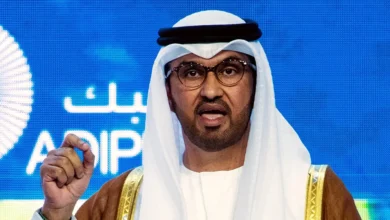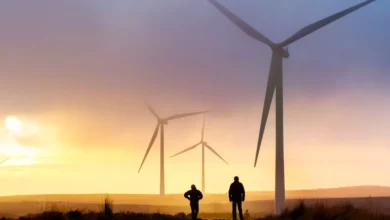Inflation and recession: Can the world defeat both in 2023?

When global leaders gathered at the annual World Economic Forum conclave in Davos last month, they were looking at a bleak economic scenario.
Two-thirds of the economists polled by the WEF for its Chief Economists Outlook report said a global recession – a shrinking of the world’s gross domestic product – was likely in 2023. Also in January, the World Bank warned the global economy was “perilously close to falling into recession”.
Since then, the International Monetary Fund in its end-January assessment has presented a less pessimistic forecast, suggesting that the global economy might avoid contraction this year. Still, the IMF has predicted that the United Kingdom’s economy will shrink and has cautioned that the United States has only a “narrow path” to escaping a recession.
The IMF, World Bank and many other experts have pointed to one key factor pushing the economy towards a recession: sharp interest rate hikes by central banks in recent months to tame soaring inflation.
So does the world need to choose between spiralling prices and a recession whose threat itself has sparked major layoffs, with more than 100,000 tech workers fired just in January? Amid economic crises, do people in effect need to choose between affordable fuel and a steady job? Al Jazeera posed these questions to leading economists.
The short answer: Curbing inflation is a painful exercise and, in most cases, leads to an economic slowdown. Yet it is a vital task for central banks because high prices affect the poor the most. The somewhat good news: Europe – a continent confronted with Russia’s brutal war and resulting energy shortages – might be showing how inflation can be tackled without tipping the economy into recession.
Decoding interest rates
The primary job of central banks is to achieve price stability. In fact, most central banks in developed countries target consumer price inflation near 2 percent – and they aim to keep prices in control by managing the amount of money and credit available in the economy.
The interest rate at which they lend to other banks is their most important tool. Low rates allow businesses and people to borrow more from banks. This, in turn, drives economic activities.
Amid the COVID-19 pandemic that crushed the global economy because of lockdowns and supply chain bottlenecks, central banks around the world cut interest rates to spur demand – an approach known as a loose monetary policy.
However, as economies opened up, consumer spending rose sharply, leading to decades-high levels of inflation. In response, central banks tightened their monetary policy and hiked interest rates to increase the cost of borrowing money.
Since early last year, the US Federal Reserve has increased the interest rates by 4.5 percentage points, with its latest hike on February 1. In the same period, the European Central Bank has hiked rates by 2.5 percentage points. In some countries like Brazil, the interest rate hike has been much sharper – by 11.75 percentage points since March 2021, and in Sri Lanka by 10 percentage points.
The idea is to lower consumer demand with the hope that people will postpone spending money to buy a car or go on a vacation.
The approach appears to be working in many countries, which are seeing inflation levels cool a bit. In the US, for instance, inflation has come down sharply from a four-decade high of 9.1 percent in June 2022 to 6.5 percent in December. In Brazil, consumer price inflation has eased from its peak of 12.1 percent last April to 5.8 percent in December.
However, increased interest rates have other consequences for the economy too.
Sonal Varma, managing director and chief economist for India and Asia (excluding Japan) for financial services group Nomura, said that as borrowing costs go up, companies slow down on investments or start reducing their workforce.
That, according to experts, is a bitter pill that economies – and the millions of workers driving them – often have no option but to swallow.
Breaking the inflation spiral
The economic logic of curbing inflation is simple, suggested Varma.
Higher prices force people to demand better wages, she said. While increased wages in themselves are a healthy sign, they also raise expenses for companies. “That will feed back into higher prices as firms will increase the cost of their goods and services,” Varma told Al Jazeera. “This will create a negative spiral.”
It’s a spiral that often hurts the poorest people the most, because they usually have low bargaining power when it comes to wage negotiations and lack sufficient savings to deal with the rising cost of living.
But as central banks increase interest rates to tamp down on demand, an economic slowdown – and in some cases, even recession – is a direct outcome. And economists expect central banks to continue hiking rates, at least in the near future.
“We will have to engage in more aggressive [monetary policy] tightening,” Willem H Buiter, a former member of the Monetary Policy Committee of the Bank of England and former chief economist at Citibank, told Al Jazeera. “And the result of that will be an economic slowdown everywhere, and depending on the country, this could take the form of a full-fledged or a mild recession.”
Radhika Pandey, a senior fellow at the New Delhi-based National Institute of Public Finance and Policy (NIPFP), agreed. Public comments made by the US Federal Reserve point to its plans to keep increasing the cost of borrowing until job vacancies go down or signs of an impending recession are clearer, she said. The latest data shows that job openings in the United States rose to a five-month high in December – a reflection of a strong labour market.
Another way
Yet the IMF’s recent, hopeful suggestion that the global economy might grow in 2023 indicates that a recession isn’t an inevitable outcome of the fight against inflation.
To maintain price stability while avoiding recession, central banks need support from their countries’ governments through other policies, said Moschella of Scuola Normale Superiore. “The central banks’ monetary policy tools work best to address the demand problem. But the central banks cannot tackle the supply-side issues, for instance, the energy shock,” she said.
Europe’s already providing an example that appears to be working – the IMF referred to the continent’s “better-than-expected adaptation to the energy crisis” as a key reason why the world might avoid a recession.
Many countries in Europe have tried to subsidise high energy costs, put caps on electricity prices for vulnerable population groups or introduced tax incentives.
Take the case of France. It froze household gas prices at October 2021 levels and capped the electricity price increase in 2022 at 4 percent over the previous year.
To be sure, the global cost of living crisis has affected French and Spanish families too, and recent pension reform proposals by the government of French President Emmanuel Macron have sparked protests. But the measures to control energy prices meant that France and Spain had the lowest inflation rates among major Eurozone economies in 2022.
In all, the IMF has said that the “resilience” shown by Europe in terms of its economic performance is partly because of the government support to the tune of 1.2 percent of the European Union GDP to households and firms hit by the energy crisis. By November last year, EU countries had set aside 600 billion euros ($654bn today) for these measures.
By helping curb inflation, these measures have allowed the European Central Bank to raise interest rates less than other developed economies like the US. And Europe’s economy, which was expected to shrink in the last quarter of 2022, instead grew marginally by 0.1 percent.










